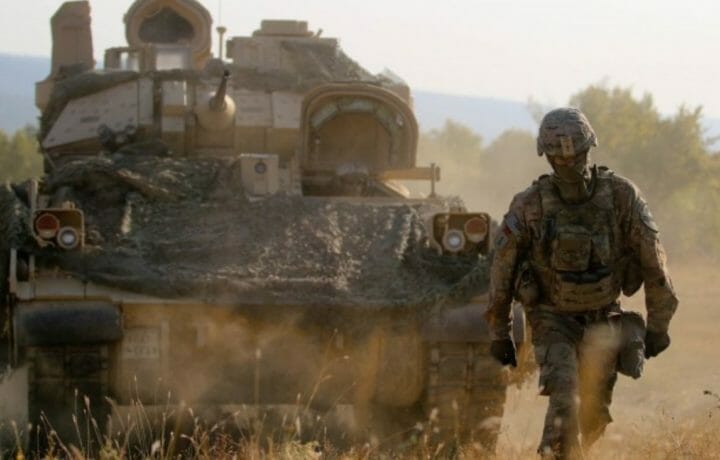After decades of wearing the blue Army Service Uniform (ASU), in 2017, the United States Army opted to adopt an Army Green Service Uniform (AGSU) that was inspired by the “pinks and greens” worn by the “Greatest Generation” during the Second World.
Green is once again the color of the United States Army, but the entire Department of Defense (DoD) is looking to go green well beyond uniforms. Earlier this year, lawmakers in Washington introduced legislation that would force the Pentagon to aggressively speed up efforts to adopt more environmentally friendly vehicles. It doesn’t mean that the military’s tanks and other fighting vehicles need to be battery-powered, but it would require that at least 75% of the non-tactical vehicles purchased or leased by the DoD would need to be electric or zero emission.
“Transitioning the military’s non-tactical fleet of vehicles to electric or other zero-emission vehicles would have a significant impact on the U.S. government’s greenhouse gas emissions,” Sen. Elizabeth Warren (D-Mass.), co-author of the Military Vehicle Fleet Electrification Act (MVFEA), said via a statement. “This is an effective solution that helps us tackle the climate crisis and keeps the military ready for the future.”
President Joe Biden has also called for the military to invest in climate-friendly vehicles, despite the potential extreme costs.
“We’re going to start the process for every vehicle in the United States military, every vehicle is going to be climate-friendly,” Biden said in remarks at the White House in April. “Every vehicle. I mean it. We’re spending billions of dollars to do it. One of the things I’ve found out as the President of the United States is I get to spend a lot of that money.”
The Charge of the Hybrid Combat Vehicles
The U.S. Army’s climate plan, released earlier this year, has called for a fully-electric non-tactical fleet by 2035, but the Pentagon is already exploring how hybrid and fully-electric technology could be employed on combat vehicles.
It was announced in June that AM General would soon unveil a hybrid-electric version of its Humvee, dubbed the “Humvee Charge.” Its capabilities could meet the demands of the United States National Guard (USNG).
In addition, the Army has been eyeing a hybrid model of its Bradley Fighting Vehicle (BFV), and unveiled an electrified prototype earlier this year. That particular effort, led by the Rapid Capabilities and Critical Technologies Office (RCCTO), was to help with the development of future hybrid electric technologies, and test the effectiveness of the Bradley Hybrid Electric Vehicle (BHEV), which could give Army senior leaders a decision point on whether or not to move forward.
“The BHEV prototype truly has the potential to improve how our Soldiers execute their missions while providing the Army with a cost-effective advantage on the battlefield,” explained Stanley Darbro, RCCTO deputy director earlier this year. “We’re executing this approach through a 24-month rapid prototyping effort with the expectation it will provide proven increased operational capability for Army-wide application.”
The U.S. Army has further announced that it will be conducting studies of its hybrid Bradley prototypes at the Aberdeen Proving Ground, MD where the test vehicles will be driven over rough terrain to measure performance. Later this year, the vehicles will then be sent to Yuma Proving Ground, AZ, for additional field assessments and to compare performance data between the BHEV and non-hybrid electric Bradley vehicles.
“Since the U.S. military services collectively operate the largest vehicle fleet on the planet, it is an obvious target and opportunity for EV technologies,” technology analyst Charles King of Pund-IT told ClearanceJobs. “Add to that that the military services reportedly account for over half of the U.S. government’s carbon footprint, and moving to electric or hybrid power trains could make a significant impact on carbon reduction.”
There have been concerns raised by some that the technology could impact readiness, but King said that hybrid technology shouldn’t be a factor.
“The Military Fleet Electrification Act doesn’t appear to threaten military preparedness,” King continued. “For one thing, both hybrid and EV technologies are well-established and reliable, and are already being produced or developed by vendors that engage with the DoD. Additionally, the Act only applies to non-tactical vehicles – not surprising given the way that issues, including temperature and terrain can impact EV performance. Overall, the Military Fleet Electrification Act seems well-designed and reasonably intended.”
Waging a War Already
The Pentagon is already fighting a battle over environmental concerns. It was earlier this month that a federal judge ruled that the U.S. Navy’s environmental review process for its Growler jet program expansion on Whidbey Island illegally failed to analyze the impacts of the noisy, often low-flying jets on classroom learning and local birds — a violation of the National Environmental Policy Act.
The Boeing EA-18G Growler is a specialized version of the two-seat F/A-18F Super Hornet, which was developed to serve as a carrier-based electronic warfare aircraft. It was designed to provide tactical jamming and electronic protection to U.S. military forces around the globe. The Navy regularly conducts training operations from the Naval Air Station Whidbey Island, and low rumbling noise from the aircraft could often be heard throughout the Greater Victoria communities.
The Washington State Attorney General’s Office has challenged the Navy’s March 2019 decision to authorize a significant expansion of its Growler program, which would increase flight operations on Whidbey Island to more than 110,000 per year.
“The Navy has an important job,” said Attorney General Bob Ferguson. “But that does not relieve the federal government of its obligation to follow the law and take a hard look at the public health and environmental impacts of its programs.”
Ferguson added that the judge ruled that the Navy fell short of its obligation. For now, it looks as if the Navy will have to find another place to fly the aptly named Growler.




